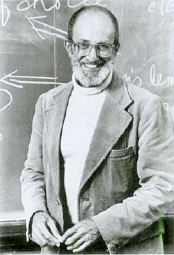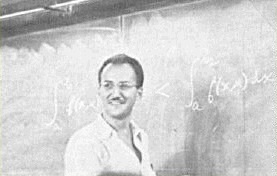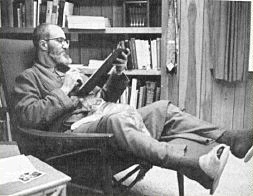born: Mar 3, 1916 in Budapest, Hungary
Won awards for mathematical exposition and teaching. Wrote several classic textbooks and dozens of research papers in probability, algebraic logic and functional analysis. Edited several journals and textbook series. Held university positions at Illinois, Syracuse, Chicago, Michigan, Hawaii, Santa Barbara, Indiana and Santa Clara, as well as visiting appointments at the Institute for Advanced Study at Princeton, Montevideo, Miami, Harvard, Tulane, Washington, Berkeley, Edinburgh and Perth. Guggenheim Fellow.
Paul Halmos lived in bustling, culturally rich Budapest until he was a teenager. In 1924 his father, a widower and successful physician, anticipated the political storm to come in Europe, and emigrated to America. While he was establishing a new practice in Chicago, he remarried and brought Paul’s two older brothers to the United States. As soon as he became a naturalized citizen, he sent for thirteen-year-old Paul. “In view of my father’s citizenship I became an instant American. I don’t feel Hungarian. By culture, education, world view, and everything else I can think of — I feel American. I speak English with an accent, but I speak it infinitely better than I speak Hungarian. In every respect, except accent, I am an American.”
Due to some confusion about the Hungarian school system, Halmos was mistakenly placed in the 11th grade instead of the eighth. Language was “a hell of a problem” for a while, but in six months or so “I spoke rapid, incorrect, ungrammatical, colloquial English.” At the age of 15 Halmos graduated from high school and enrolled at the University of Illinois. “I was tall for my age and cocky. I pretended to be older and got along fine.” Halmos was definitely not a prodigy. He was good at balancing equations and differentiating things, but “I was a routine calculus student — I got B’s. I didn’t understand about limits. I just wanted to take courses and see what happened.” Yet, he finished a bachelor’s degree in three years. “I was too unimaginative to stop school, so I went to graduate school.” As a graduate student he flunked the master’s exam in philosophy. “But nothing would stop me. I continued taking courses [in mathematics],” even though, at the time, “I thought a lot of it was fussing about silly hair-splitting.” Then one afternoon “I remember standing at the blackboard in Room 213 of the mathematics building talking with [a classmate] and suddenly I understood what limits were. All that stuff became clear. That afternoon I became a mathematician.”
Halmos finished his Ph.D. in 1938, typed 120 letters of application, and got two answers: both NO. “The U of I took pity on me and kept me on as an instructor.” In the middle of that year a friend who was a year behind Halmos received a fellowship at the Institute for Advanced Study. “That made me mad. I wanted to go, too! So I resigned my teaching job, borrowed $1000 from my father, [wrangled] an unsupported membership (= a seat in the library) at the Institute, and moved to Princeton.” In his second year there, Halmos became John von Neumann’s assistant. His job was to attend lectures, take notes and sometimes type them up and have them duplicated. In 1942 Halmos produced a monograph, Finite-Dimensional Vector Spaces, which was “based on [some of] von Neumann’s lectures and completely inspired by him. That’s what got me started writing books.”
Halmos at U of Chicago, 1949, 19K Halmos was off and running. After a short stint at Syracuse University, he spent the late 1940’s and the 1950’s as a junior member of the University of Chicago’s powerhouse mathematics department. He calls those years “the most stimulating and fruitful period of my life ….” There he built a reputation as an ambitious researcher, a stern, but popular teacher, and an eloquent writer of textbooks. In 1960 Halmos was lured to the University of Michigan by a 30% increase in salary, a cushy large office, a half-time secretary, and an academic promotion. (“…. from a small frog in one of the best ponds to a very large frog in an acceptably good pond.”) At the end of the 60’s he served a year as chair of the University of Hawaii’s mathematics department, but left when the newness of being in charge and the initial attraction of the “poetically blue sky, sand of gold and the soothing scent of plumeria [a tropical flowering shrub]” wore off. “Eager to get back to the real world,” he accepted a professorship at Indiana University. He remained a Hoosier throughout the 70’s and half of the 80’s, then moved to Santa Clara University, a relatively small undergraduate school where they “see the sun a lot.”
Halmos is renowned for his “popular” writing and speaking about mathematics. He has won several awards for expository writing, and in 1993, he received a Distinguished Teacher award from the Mathematical Association of America. “I am proud to be a teacher. Teaching is an ephemeral subject. It is like playing the violin. The piece is over, and it’s gone. The student is taught, and the teaching is gone ….. Writing is permanent. [It’s] very hard work for me, but I love it.” It is generally regarded as difficult to explain mathematics to nonspecialists. “The best you can do is communicate the spirit of mathematics: find the question, look for examples, guess the answer, and go on from there. I give talks on problems, not in detail, but at a level that has a chance of reaching them.” Preparation is essential. “I try very hard in my writing and in my public speaking to [appear] spontaneous, by which I mean that I prepare everything to within an inch of its life. Every single word that I publish I write at least six times. [I might practice] a talk 20 times. It’s important, not because people will pat you on the back and applaud you, but because it contributes to communication — explanation, organization, architecture, and structure. I want to make things clear, and I enjoy trying to understand and clarify mathematics (especially on the rare occasions when I succeed), more even than to discover it.”
In that first 1942, von Neumann-inspired book, Halmos established a style and perspective that have become signatures of his celebrated career. Halmos regards problems as the heart of mathematics and thinks that “it is better to do substantial problems on a lesser number of topics than to do oodles of lesser exercises on a larger number of topics.” Halmos firmly believes that “the only way to learn anything is to do that thing ….. The only way to teach is to put challenges in front of the [learner] and make him conquer them.” He is an advocate of “the so-called Moore method, which is a way to describe the Socratic question-asking, problem-challenging approach to teaching,” and he uses it, in one form or another, from beginning calculus through graduate level seminars.
Halmos is a generally colorful character with strong, sometimes controversial, opinions. His conversation is witty, articulate and compelling. Some quotes illustrate these characteristics.
“I like words more than numbers, and I always did — conceptual more than computational.”
Halmos takes group photos of all his classes. “Some day one of you is going to do something spectacular. I’ll be able to point to this picture and say, ‘See. I taught that guy everything he knows.'”
“The computer is important, but not to mathematics.”
Teaching trigonometry for industrial applications — “That’s not mathematics, that’s a trade. It [does] mathematicians good only insofar as it enables them to buy an extra TV set …. Efficiency is meaningless. Understanding is what counts.”
On the other hand, “I have the world’s most intelligent typewriter …. I spend at least six hours a day on my Macintosh.”
“When I was young, I drank like a fish and smoked heavily …. When I was forty, [I imagined] I had every disease in the book …. The doctor said, ‘Go take a long walk.’ Now I walk at least four miles a day, very hard; 10 to 15 on holiday …. I can think and daydream; and I feel my body working up to a healthy state.”
“Cats look nice; they’re interesting, loving, lovable, and somehow one is in touch with another soul.”
“I’m not a religious man, but it’s almost like being in touch with God when you’re thinking about mathematics. Learning mathematics is always extraordinarily hard work — reading it, listening to lectures. I enjoy a kind of mathematical ‘gossip,’ when people sit in easy chairs with their feet up and tell me their mathematics; then I can learn.”
“All educable human beings should know what mathematics is — that mathematics is. They would enjoy life more, they would understand life more, they would have greater insight.”
Halmos is a consummate professional. According to John Ewing, a distinguished mathematician and writer in his own right, “Many young mathematicians have learned by watching Paul Halmos. I did. Of course, we don’t all carry dog biscuits in our pockets; we don’t go around banging on doors with canes; and we don’t all share all of Paul’s strong opinions about mathematics and the world. But we do know what it means to be professional.” Halmos thinks that is the greatest compliment you can pay him.
(Click PRH for more quotes and observations about Halmos.)
Condensed by Larry Curnutt from “Paul Halmos: Maverick Mathologist” by Don Albers, Two-Year College Mathematics Journal, September, 1982; “In Touch with God” by Don Albers, Paul Halmos: Celebrating 50 Years of Mathematics, Springer-Verlag, 1991; and I Want To Be A Mathematician: An Automathography by Paul R. Halmos, Springer-Verlag, 1985.
Last Updated September 22, 2022



